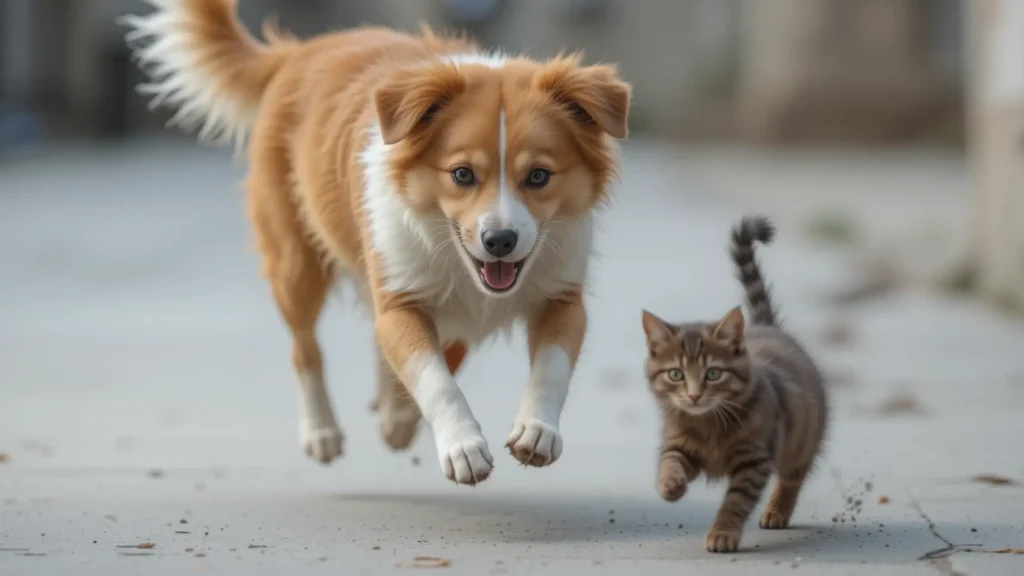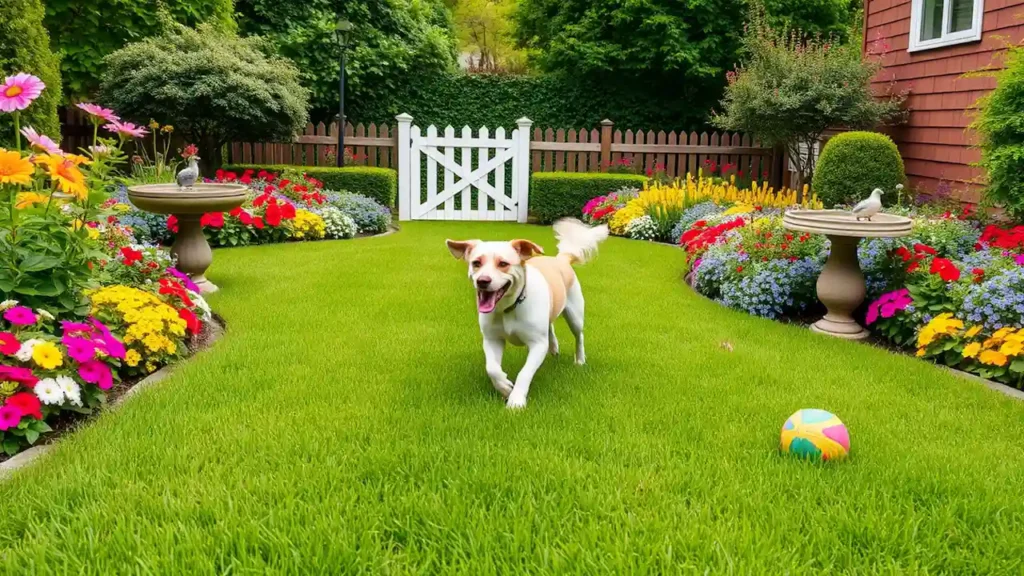Summer heat can pose significant challenges to dogs. Dogs are more susceptible to overheating than humans. They can’t sweat like we do.
As responsible pet owners, it’s crucial to take proactive steps to ensure your dog stays cool, and comfortable during the hottest months of the year.
Here’s how you can keep your dog cool in the summer.
Provide Plenty of Fresh Water
Hydration is essential for keeping your dog cool during the summer months.
Dogs primarily regulate their body temperature through panting. Through panting they lose water much faster in hot weather. So your dog quickly become dehydrated. This leads to heatstroke.
Always keep a bowl of fresh water to ensure your dog stays hydrated. If you notice that your dog is drinking more than usual, don’t be alarmed—it’s a natural response to the heat.
On particularly hot days, you can take extra steps to keep the water cooler for longer by adding ice cubes to the bowl. This lowers the water temperature.
Bring along a portable water bottle and a collapsible bowl when going outdoor. Many pet stores sell specially designed travel water bottles with built-in bowls. This combination makes it easy to offer your dog a drink whenever they need it. Remember, even short periods of dehydration can be dangerous. So never skip this step when you’re away from home.
Create a Cool Indoor Space
Your home should serve as a refuge from the sweltering summer heat. Provide your dog with a comfortable environment where they can relax and cool off. The first step is ensuring proper ventilation.
If you have air conditioning, keep it running at a moderate temperature that’s comfortable for both you and your pet. If air conditioning isn’t an option, fans can help circulate air and create a breeze.
Otherwise, consider using damp towels in shaded areas. Simply soak a towel in cold water, wring it out, and lay it over your dog’s bed. Cooling mats are another great option. These mats absorb your dog’s body heat and provide a refreshing surface for them to lie on.
Basements and tiled floors are naturally cooler spaces. Encourage your dog to spend time in these areas if possible. Dogs instinctively seek out cooler surfaces when they’re feeling overheated. You may notice them lying on tile or concrete floors more frequently during the summer.
Additionally, investing in pet-safe cooling products like gel-filled vests or bandanas can further help regulate your dog’s body temperature. These products are designed to stay cool for extended periods. They can be helpful during heatwaves.
Limit Outdoor Activity During Peak Heat Hours
The sun’s intensity peaks between 10 a.m. and 4 p.m. Outdoor temperatures can become dangerously high for dogs. Playing outside during these hours puts your dog at risk of overheating, dehydration, and burns on their paw pads.
To protect your furry friend, it’s best to schedule outdoor activities for the early morning or late evening. These times the air is cooler and the sun is less intense.
Before heading out for a walk, always check the pavement with the back of your hand. If the surface feels too hot for your skin after just a few seconds, it’s too hot for your dog’s paws. Hot pavement can cause painful burns and blisters. Opt for grassy or shaded paths instead.
If you must walk on paved surfaces, consider protective booties designed for dogs. These lightweight shoes shield their paws from heat and rough terrain.
Another important consideration is the duration of outdoor activity. Even in cooler parts of the day, excessive exercise can elevate your dog’s body temperature. Shorten walks and monitor your dog closely for signs of fatigue. If your dog starts panting heavily, drooling excessively, or lagging behind, it’s time to head back inside and let them rest.
Offer Frozen Treats
Dogs love treats. Frozen snacks are a delicious way to help them beat the heat. Not only do these icy goodies cool your dog down, but they also provide mental stimulation and entertainment. Best of all, you can easily make homemade frozen treats using dog-friendly ingredients.
One popular recipe involves blending plain yogurt with peanut butter. Make sure it’s xylitol-free. Pour the mixture into ice cube trays or silicone molds. You can also add small pieces of fruit like blueberries, strawberries, and bananas for extra flavor and nutrition. Once frozen, these pup-friendly popsicles are ready to enjoy!
For simpler options, freeze chunks of watermelon, apple slices, or carrot sticks. Just be sure to remove any seeds and pits. They are harmful for your dog.
Another idea is to fill a Kong toy with wet dog food, peanut butter, and mashed pumpkin and freeze it. This creates a long-lasting treat that keeps your dog occupied while cooling them down.
Groom Dog Appropriately
Proper grooming for dogs is vital in helping them cool during the summer. While it might seem logical to shave your dog’s coat to combat heat. But actually, doing so can actually do more harm than good. A dog’s fur serves as insulation. It protects them from both heat and cold. Completely shaving their coat can leave them vulnerable to sunburn and overheating.
For long-haired breeds, brush regularly to maintaining a healthy coat. Brushing removes loose fur. It prevents matting, and improves airflow through their coat. Overall, it helps dissipate heat.
If necessary, consult a professional groomer to trim your dog’s fur appropriately. Trimming reduces bulk without compromising the insulating properties of their coat.
Short-haired breeds, on the other hand, may benefit from additional protection. Dogs with light-colored and thin coats are prone to sunburn. Apply a pet-safe sunscreen formulated specifically for dogs. Avoid using human sunscreen.
Use Cooling Accessories
In recent years, the pet industry has introduced a wide range of innovative cooling accessories designed to help dogs stay comfortable in hot weather. These products are easy to use.
One popular option is cooling bandanas and collars. These accessories retain water and cool through evaporation. To activate them, simply soak the bandana and collar in water, wring out the excess, and place it around your dog’s neck.
As the water evaporates, it draws heat away from your dog’s body. This provides a refreshing sensation. Some cooling collars can last for hours before needing to be re-soaked.
For more comprehensive cooling, consider investing in a cooling vest. These vests cover a larger portion of your dog’s body. They work similarly to cooling bandanas. They use evaporative technology to lower their core temperature. Cooling vests are particularly beneficial for active dogs who enjoy hiking, running, and playing fetch in warm weather.
Another useful accessory is a portable misting fan. These handheld devices spray a fine mist of water and generate a gentle breeze. You can use them during walks, at the park, and indoors. For outdoor enthusiasts, portable shade tents are another great option. These pop-up shelters provide a cool, shaded area where your dog can relax.
By incorporating these cooling accessories into your routine, you can give your dog an extra layer of protection against the summer heat.
Watch for Signs of Heatstroke in Dogs
Heatstroke is a medical emergency. Ic can escalate quickly. It poses a serious threat to your dog’s life. Recognizing the early signs of overheating is critical to preventing severe complications.
The first noticeable symptom is excessive panting. If the panting becomes rapid and labored, it may indicate that their body is struggling to regulate its temperature. Other warning signs include drooling, lethargy, vomiting, diarrhea, confusion, and in severe cases, collapse. If your dog exhibits any of these symptoms, act immediately.
The first step is to move your dog to a cooler environment. Offer small amounts of water to rehydrate them. Avoid forcing them to drink large quantities all at once. This could upset their stomach. To lower their body temperature, dampen towels with cool (not ice-cold) water and gently drape them over your dog’s back. Focus on areas like the neck, armpits, and groin. Alternatively, you can place your dog in front of a fan to accelerate the cooling process.
It’s important to note that submerging your dog in ice-cold water or applying ice packs directly to their skin can cause their blood vessels to constrict, trapping heat inside their body and potentially leading to shock. Instead, aim for gradual cooling.
Even if your dog seems to recover after initial treatment, it’s essential to contact your veterinarian as soon as possible. Heatstroke can cause internal damage that isn’t immediately visible. Professional evaluation is crucial to ensure your dog’s long-term health.
Never Leave Your Dog in a Parked Car
Leaving your dog in a parked car is one of the most dangerous mistakes a pet owner can make. On a sunny day, the interior temperature of a vehicle skyrocket within minutes, regardless of whether the windows are cracked open.
Studies show that even on mild days with temperatures as low as 70°F (21°C), the inside of a car can reach 100°F (38°C) within 20 minutes. This rapid rise in temperature can quickly lead to heatstroke.
Dogs trapped in hot cars experience extreme distress. They may begin panting heavily, drooling excessively, and attempting to escape. Without intervention, they can succumb to heatstroke in as little as 15 minutes.
If you need to run errands, leave your dog at home in a cool environment. Alternatively, seek out pet-friendly stores where your dog can accompany you safely. Some businesses offer amenities like water bowls and shaded seating areas for furry companions.
Provide Shade and Shelter Outdoors For Dogs

Create a comfortable and safe outdoor space in the yard. It is essential for their well-being during the summer. Direct sunlight can quickly elevate your dog’s body temperature. Providing ample shade is non-negotiable.
Natural shade sources like trees and shrubs are excellent options. They block the sun and allow airflow. If your yard lacks sufficient tree cover, consider installing artificial shade solutions such as pergolas , awnings , and canopies. These structures can be positioned strategically to create cool retreats throughout the day.
For a permanent solution, invest in a pet shelter designed specifically for outdoor use. Look for models made from insulated materials that reflect heat. Elevating the shelter off the ground can also improve airflow and keep the interior cooler.
Another fun and effective way to help your dog beat the heat is by setting up a kiddie pool filled with shallow water. Many dogs love splashing around the water. This naturally lowers their body temperature. Ensure the pool is placed in a shaded area. Always supervise your dog while they’re in the pool.
Additionally, consider adding a misting system to your backyard. These systems spray a fine mist of water into the air. This creates a refreshing oasis for your dog to enjoy. Pairing a misting system with shade ensures maximum comfort during the hottest parts of the day.
Know Your Dog’s Unique Needs
Every dog is different. Understanding your pet’s individual needs is key to keeping them safe in the summer. Background history of breeds, and their age, size, coat type significantly influence how well your dog tolerates heat.
Brachycephalic breeds are particularly susceptible to overheating due to their shortened snouts and restricted airways. These dogs have difficulty breathing. This makes it harder for them to cool down through panting. Limit their outdoor activity during hot weather.
Senior dogs and puppies are also at higher risk of heat-related issues. Older dogs often struggle with mobility. Their underlying health conditions impair their ability to regulate body temperature. Puppies, on the other hand, are still developing their thermoregulation systems. They can overheat quickly. Both groups require extra vigilance and care during the summer months.
Dogs heart disease, obesity, and respiratory disorders face additional challenges in hot weather. Consult your veterinarian for personalized advice on managing your dog’s condition during the summer.
Lastly, pay attention to your dog’s behavior and preferences. Some dogs are naturally more heat-tolerant than others. By observing your dog closely and adapting your approach accordingly, you can ensure they remain happy and healthy all summer long.




